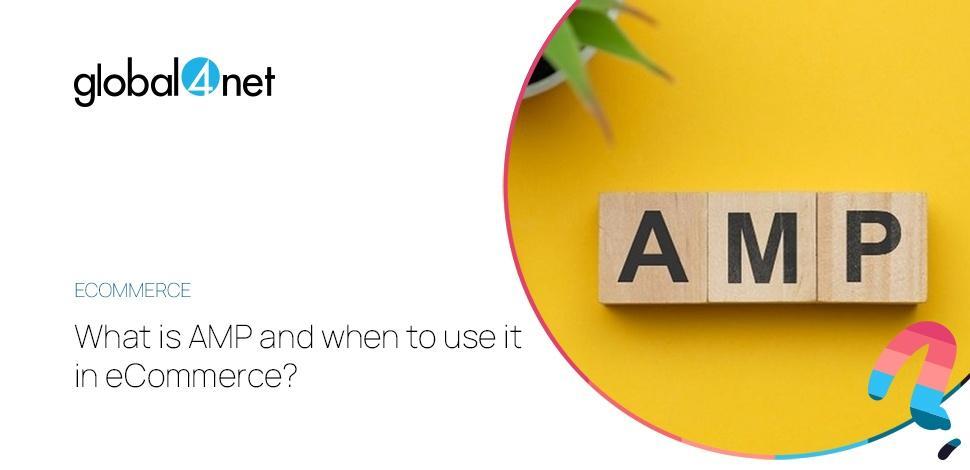ul. Strzegomska 2-4
53-611 Wrocław
NIP 8992786490
KRS 0000608120
REGON 363987723
Global4Net Sp. z o. o.
+48 71 358 41 00
© 2009 – Global4Net. All Rights Reserved.

The difference between mobile internet users and the ones using desktop to surf online is steadily increasing. The official statistics highlight that, globally, mobile devices have roughly 10-15% higher market share than desktop devices. This difference is impacting the behaviour of eCommerce players. More and more brands are starting to prioritise native, progressive and cross-platform apps in their business models. Another technology that aims at optimising web apps for mobile devices is AMP – Accelerated Mobile Pages (library of components), which is connected with Mobile First Approach.
AMP (Accelerated Mobile Pages) is a platform of components from Google. It was designed to improve the quality of user experience of mobile web pages and mobile applications. Furthermore, as it is mentioned on the main page of AMP, the tool is putting the user, operation speed and conversion as the first priority. To improve those aspects, AMP consists of HTML tags, dedicated JavaScript library and tool for caching AMP sites.
The AMP components are easily accessible and can be used in a couple of intuitive ways:
Additionally AMP is supported by engineers from Google, who work on the tool and constantly upgrade it. Moreover, there is a whole component library with AMP-dedicated pages and meticulous description of each component available on the project main page.
But, how will my users know that you built my page with AMP? In the search results window your webpage will be shown as AMP-backed: it will have a lightning symbol that will let the users know that this page is made for mobile devices. Another important question is if building pages with AMP affects Google ranking? The answer is: yes, indirectly through the increased speed of functioning. Therefore, a well-built AMP application can improve your ranking by the loading speed factor. Also, remember that the AMP icon is only visible in search results on mobile devices, not on desktop.
Moreover, the Google AMP Cache tool helps in even faster caching of pages, which additionally optimises the loading speed. If you are not confident that your AMP page is doing as well as it should, you can implement the amp-analytics component, which is compatible with Google Analytics. Thanks to that, you will be able to see the statistics, such as the user’s engagement rate.
Most of the time you will want to use AMP for building pages with lots of articles. Thus, it will be perfect for establishing a blog page for your eCommerce. However, due to lack of areas regarding variable data, it is not a great choice for product content creation. Its strength lies in quick loading and service of static data, the type that is not as frequently updated as the product data. In spite of this limitation to static data, AMP can still significantly improve the quality of web pages. Krzysztof Baraniecki, web developer at Global4Net underlines:
“AMP has been created for speed. Thanks to quick load time of pages Google can better position our website. In this way, improving pages with AMP increases the chance of customer acquisition, reduction of bounce rate and rise of conversion.”
As the name suggests, the Accelerated Mobile Pages technology is focused on web pages prepared for mobile devices. That is why it is worth it to commence web development with the Mobile First approach alongside AMP tools. But what is the Mobile First approach anyway?
MF is a development approach that focuses on prioritising the mobile users rather than desktop ones. Therefore, it recommends developing the mobile versions of websites first, and then scaling it to the desktop devices. The Mobile First approach combines Responsive Web Design and UX scaling. Why is it worth developing eCommerce like that? There are a couple of reasons:
Responsive Web Design is the industry standard, the use of mobile devices rises exponentially, and AMP apps are increasing this rise even further. It’s not odd that many businesses are profiting from the combination of both of these technologies. For example, the Washington Post increased its loading speed by 88% in comparison to the traditional mobile pages. Another eCommerce company based in the US Carved has increased its conversion rate by 75% and reduced bounce rate by 33% after implementing AMP and PWA.
After you have built your AMP page it’s time to test if all the HTML tags are where they’re supposed to be. Otherwise, Google will not cache the page as one. The tool that enables you to check if your page meets the requirements is the AMP Validator. All you have to do is to paste your page code and the Validator will check for any mistakes.
You have to make sure that each HTML code line includes the prefix “amp”. Thanks to that, Google crawlers will check your page according to the indications set for this kind of apps.
If you are sure that you have the possibility or resources allowing for building Accelerated Mobile Pages, or you simply want to have the guarantee of high quality – contact us and together with our IT specialists we will find a way to help you.
Write to us




